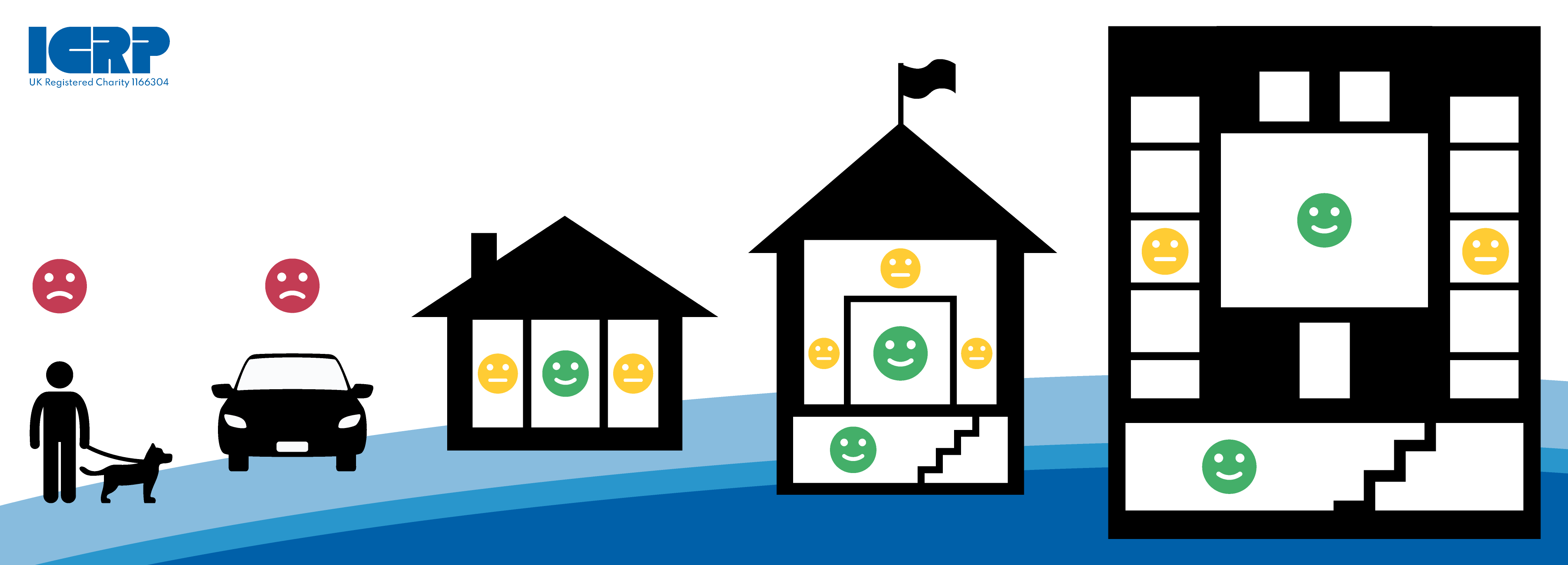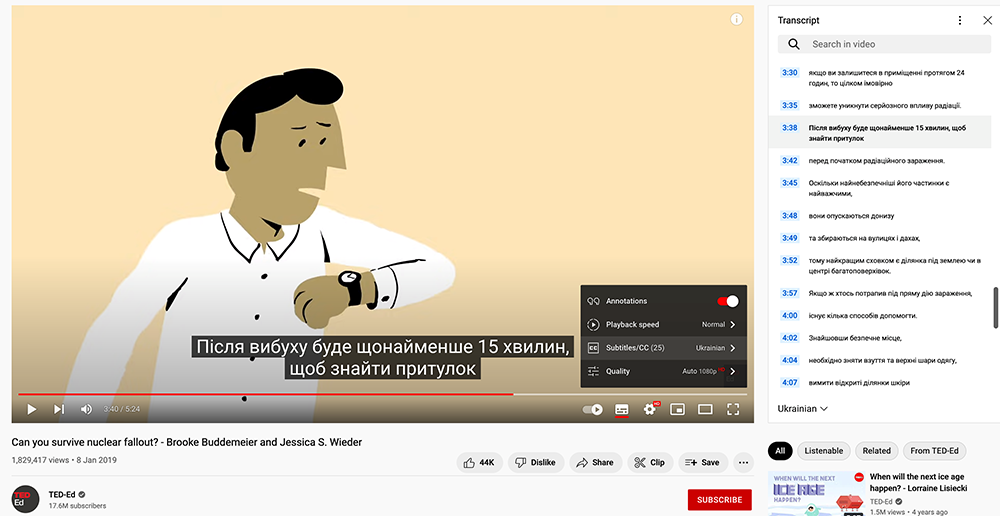[عربى] [বাংলা] [Dansk] [Deutsch] [English] [Español] [Français] [हिन्दी] [Italiano] [日本語] [한국어] [मराठी] [Polski] [Українською]
Advice for the Public on Protection in Case of a Nuclear Detonation
THIS SCIENTIFICALLY SUPPORTED ADVICE COULD BE LIVESAVING
| Although we hope this information will never need to be put into action, ICRP has summarised publicly available information on protection in case of nuclear detonation here and, in partnership with SAGE publishing UK, has made ICRP Publication 146 Radiological Protection of People and the Environment in the Event of a Large Nuclear Accident immediately free to access. Meanwhile, ICRP Task Group 120 is developing protection guidance on other radiation emergencies and malicious events and more detailed advice for authorities and the public in case of a nuclear detonation. |
A nuclear detonation may occur without warning. It may result in mass casualties.
There are steps you can take to protect yourself and your family from the radiation after a nuclear detonation.
Go inside and stay inside. Get inside the center of a building or basement to put as much material between you and the radioactive material outside.
| THE FIRST 10 MINUTES THE FIRST 24 HOURS THE NEXT 48 HOURS UNDERSTAND THE HAZARDS HOW TO BE PREPARED FOR A NUCLEAR DETONATION RESPONDING TO ALERTS |
THE FIRST 10 MINUTES
A nuclear detonation, whether from a missile or small portable device, may result in mass casualties. Adequate preparation and appropriate response to a nuclear alert or detonation can protect you and your family's health and life. The best way to protect you and your family before, during, and after a nuclear blast is getting inside the centre of a building or basement. On August 6, 1945, Mr Eizo Nomura was in the basement of a building in Hiroshima, about 170 meters from ground zero. He survived the atomic bombing and died in 1982 at the age of 84 [ref]. Most people within a few hundred metres of a nuclear detonation are not likely to survive, especially if unprepared.
Be inside before the fallout arrives. After a detonation, you will have 10 minutes or more to find an adequate shelter before fallout arrives. If a multi-story building or a basement can be safely reached within a few minutes of the explosion, go there immediately. The safest buildings have brick or concrete walls. Underground parking garages and subways can also provide good shelter.

The best thing you can do after a nuclear detonation is go inside. Put as much material as possible between you and the radioactive material outside.
THE FIRST 24 HOURS
If you think you may have been exposed to fallout, outer layers of contaminated clothing and footwear should be removed, and any exposed skin and hair wiped off or washed. Any potentially contaminated pets should be brushed in a room away from where people are sheltered and washed if possible. Further information can be found here and here (video).
Food, drink, and medicine already in stores (shops) or in your shelter are safe to consume.
Tune in to any available media, such AM/FM stations using a battery-powered radio, for updated instructions. Stay inside unless instructed otherwise.
The danger from fallout will decrease rapidly. Remain in the most protective location (basement or centre of a large building) for the first 12 – 24 hours unless threatened by an immediate hazard (e.g., fire, gas leak, building collapse, or serious injury) or informed by authorities that it is safe to leave.
Self-evacuation is strongly discouraged until hazardous fallout areas have been identified and safe evacuation routes established.
In many areas, essential workers can be released from shelter for short periods to perform critical support and life-saving activities.
Further information on how to prepare, how to survive, and what to do after a nuclear detonation can be found here and in this 5-minute video with subtitles available in many languages.
THE NEXT 48 HOURS
You have been sheltered because of the potential for dangerous levels of radiation in the first 24 hours following a nuclear detonation. After 24 hours, outdoor radiation levels will have fallen significantly but may still warrant protective measures in your area.
- Tune in to any available media for updated instructions. Be prepared to evacuate if instructed.
- Minimize time spent outdoors if you must go outside, maximize time spent in the most protective locations within your shelter.
IF INSTRUCTED TO REMAIN SHELTERED OR NO GUIDANCE HAS BEEN PROVIDED
- Stay inside unless there is a life-threatening emergency, such as a medical emergency or your shelter is threatened by fire, collapse, or another hazard.
- If you must go outside for life-sustaining reasons or for a more robust shelter with food and water, reduce time spent outside and cover your nose and mouth with a mask or cloth. If possible, cover your shoes and clothes with an additional layer (e.g. plastic, tissue). On return, remove the additional layer, shoes and outer layer of clothing and then wipe or wash exposed areas of skin with soap and water.
- Children and pregnant women are more sensitive to radiation and should maximize their time in the most protected areas within the shelter (the middle of the building or basement areas).
- Continue to consume stored food and drinking water sparingly, as you may have to shelter for several days. Packaging/containers from outside should be wiped or rinsed off first. Wash hands before handling food. Avoid harvesting and consuming fruits and vegetables from local gardens, as they may be contaminated.
- Unless informed otherwise, tap water is safe for washing or even drinking if no alternative supply is available.
- If possible, consider establishing a self-help first aid location/space/room in a protected building/shelter. Inform others through ad hoc signage. Support the care of vulnerable populations such as children, elderly, and those with disabilities.
- Separated family members should remain in their own shelter. Going outside to collect loved ones may expose you and them to radiation.
- Parents separated from their children should not try to access the schools or childcare facilities unless informed otherwise as they will put themselves and their children at risk.
- Request help for medical emergencies only if you have a life-threatening medical condition. Be prepared to wait longer than usual for a response and before assistance can be provided.
- Do not go to a hospital unless you have a life-threatening medical condition.
IF INSTRUCTED TO EVACUATE
Follow the instructions of emergency officials.
If you are at home:
- Take necessary medicines, a change of clothes and shoes for all family members, as well as cell phones, and any important medical or legal papers.
- If evacuating with pets, bring a kennel/cage, leash, pet food, pet medications, and veterinary records (if readily available).
- Comply with instructions on how to collect children from school or elderly relatives from nursing/care homes, if separated from them.
- Take disaster supplies with you (such as a torch/flashlight and extra batteries, battery-powered AM radio, first aid kit and medications, emergency food and water, sanitary supplies (diapers, toilet paper, wet wipes), can opener, spoon, knife or scissors, cash and credit cards).
- Once you evacuate, do not return until you are told it is safe to do so by authorities.
If you are not at home:
- Follow instructions from the authorities and do not return to your home unless you are told you can do so.
UNDERSTAND THE HAZARDS
Understand the hazards of a nuclear blast, be prepared for a nuclear alert, and act wisely. Below are some of the hazards produced by a nuclear detonation:
A bright flash of light enough to cause temporary flash blindness 10 km or more away would be an indication of a nuclear explosion.
Thermal pulse - Immediately after a blast, a fireball of extremely hot gases produces thermal pulses which may last for several seconds and cause skin burns, eye injuries, and the ignition of combustible materials, such as vegetation and wooden structures, can occur several kilometres from the detonation site.
Blast wave - A fireball capable of destroying a few city blocks and a blast wave damaging buildings several kilometres away. Even at a few kilometres, flying fragments of broken windows and debris are very dangerous.
Initial radiation from the fireball - Initial radiation from the fireball may cause injury or death to those outdoors within a few km of the detonation.
Residual radiation from fallout - If the detonation occurs near the ground, radioactive material produced by the explosion mixes with dirt and debris. The fireball pulls this material up several kilometres into the atmosphere before falling back toward the ground. It can take 10 minutes or more for fallout to reach the earth and contaminate the ground. This fallout is most dangerous within tens of kilometres of the detonation and during the first few hours.
An additional damaging factor is an electromagnetic pulse, which produces voltage surges in power grids, telecommunication networks, and various electronic equipment. The supply of electricity, tap water, and food can be heavily affected for weeks. Mobile networks, the Internet, local TV, and FM radio can also be affected. Remote AM stations will be operational.
HOW TO BE PREPARED FOR A NUCLEAR DETONATION
Identify potential shelters at home, work, school, and while commuting. Consider basements of your house and at your workplace, shelters in nearby buildings, shops, and businesses, especially if located below ground level. Vehicles and mobile homes do not provide satisfactory protection.
Prepare and store the following items in your shelters:
- A survival kit, including a torch (flashlight) with extra batteries, power banks, and a battery-powered AM radio.
- A first aid kit with tools and medication to treat injuries and burns, as well as daily medications.
- A stock of bottled drinking water (2 L per day per person) and water for hygiene and decontamination (2-4 L per day per person) for several days. Stock for a week or two is strongly recommended. Additional water is required for pets.
- Several days of long-life food, including pet food.
- Spare clothes and footwear.
Learn first aid skills for mechanical traumas and burns.
Agree with your family and friends about your actions in the event of a nuclear detonation.
Add name tags to the clothes of small children to help find them if you are separated.
RESPONDING TO ALERTS
Seek nearby shelter. A basement, underground parking, subway, or the centre of a large modern brick or concrete building will provide adequate shelter.
If outdoors
- Move into a shelter or behind a solid object to avoid direct visibility from the point of explosion.
- If in a car, get into a nearby shelter. If no protective building is available, pull off the road and consider moving under an overpass or behind an embankment.
- Do not try to escape by car. There will likely be traffic jams and your car offers no protection from nuclear effects.
If indoors
- Avoid the vicinity of doors and windows, as the blast wave can cause them to be hazardous.
Protect yourself from the blast. If you think a detonation has occurred, drop down to the ground immediately, hide under something sturdy, covering face and head to avoid injury and flying debris.
